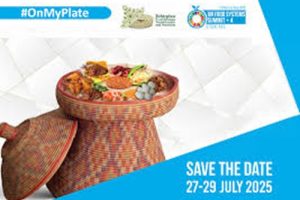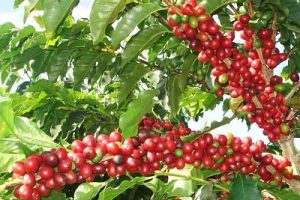
Ethiopia gives special attention to the development of the agriculture sector aiming at ensuring food security. The country sets four basic pillars in the agriculture sector with the goal of maximizing the productivity and enhancing the sector’s contribution to the nation’s economy. Increasing production and productivity, exporting of agricultural products, ensuring food security, import substitution and creating huge job opportunities in the sector remains the basic pillars.
To meet the target, the country has introduced new initiatives to increase the product and productivity through practicing dry weather irrigated farming. The ongoing summer wheat initiative is among the game changers in the sector. In addition to the continuous efforts in the development of irrigation, expansion of agricultural mechanization, diversifying crops and supplying basic agricultural inputs is also on the pipeline. The initiative is helping the country to modernize the sector.
With immense potential the Jimma zone gives due focus to the development of all agricultural activities and the ongoing efforts is showing significant positive impact on the sector, according to zone’s Agriculture Office head.
Jimma Zone Agriculture Office head, Mohammed-Taha Abafita told The Ethiopian Press Agency (EPA) that the zone is working for the holistic development of the agriculture sector so as to exploit its potential. “Jimma zone has untapped potential in crop production, coffee harvesting, milk production, beekeeping, tea farming and conserving the supportive ecosystem for boosting agricultural activities”.
As to Mohammed-Taha, efforts are underway to exploit this potential especially during the past three years during which meaningful achievements were registered.
In addition to working for enhancing the development of agricultural crops and other livestock production, the zone has introduced new crops. It focuses on diversifying the agricultural products and incentivizes farmers for cultivating crops that can be utilized as inputs for agro- industries that enhance the volume of export trade, according to the head. Through this initiative, the zone has shown increased performance in the production of honey, milk, crops, fruits and coffee during the past three consecutive years.
Crop Production
The zone focuses on the production of ten crop varieties. By introducing new technology based farming, properly using agricultural inputs and increasing the coverage of farm land, the zone’s productivity is increasing year by year. “In 2022 harvest season, Jimma zone has covered 578,000 hectares of land by different crops. In 2023 Mehere season, by adding over 200,000 hectares of land, the zone cultivated 841,000 hectares of land by crops,” Mohammed-Taha said.
He added that out of the total arable land in the zone about 235,000 hectare was covered by rice in 2023, which is a new experience for the place. Wheat, maize, barley, teff and other oilseeds were also cultivated in the rest of the farming areas, as to him.
He further said that, the productivity per hectare in 2022 was 31 quintals while in 2023, increased to 33.8 quintals. Accordingly, during the 2023 harvest season, Jimma zone harvested over 35 million quintals of products which shows 15 million quintals growth compared to the previous year, he added. The head stated that Jimma zone is becoming popular in rice production at national level especially this year.
Jimma zone started rice harvesting in 2021 in four districts covering 2000 hectares of farm land.
“In 2022 harvest season, the coverage of rice increased to 30,000 hectares of land within 12 districts. And in 2023 harvest season, the coverage of rice increased from 30,000 hectares to 235,000 hectares, which shows an exponential development,” Mohammed-Taha said. The zone has harvested over 9 million quintals of rice in 2023 mehere season.
Similarly, Jimma zone started summer wheat farming four years ago in 50 hectares of land which now develops to 441,000 hectares. Within four years, the coverage of summer wheat farming has increased from 50 hectares of land to 441,000 hectares of land in Jimma zone and it also harvests over 16 million quintals of wheat.
The effectiveness of the interventions can be seen in that they have enabled the zone to export wheat for the first time, in addition to coffee. For him, urbanization and population growth is witnessed at high rate that demands changes in the way of farming. To feed the growing population, the farming must focus on crops with high productivity and rice and wheat are the preferable crops in this regard, he said.
As to him, considering the productivity, the zone is focusing for the development of rice and wheat harvesting parallel to the common crops.
“It is difficult to feed the population through the business as usual method of farming” he said.
He also mentioned that there is a potential of producing up to 83 quintals of wheat per hectare and up to 130 quintals of rice in the zone though the average productivity currently is 39 and 42, respectively.
Similarly, coffee, fruits and tea farming are also showing exponential growth in the zone. Jimma is known for coffee and the zone focuses on maximizing coffee’s contribution to the nation economic growth. Jimma has a coffee ‘gene bank’ that conserves over 6,500 varieties of coffee.
The zone has suitable agro ecologic zones for the cultivation of various crops which helps farmers to enhance their income generation capacity. The zone in addition to surface and underground water it obtains sufficient “belg” and rain seasons water. It has also abundant wild coffee which supports in raising farmer’s income.
Currently, the coverage of coffee plant in the zone reached 530,000 hectares of land. Mohammed-Taha stated that, over 50 percent from the total coverage was planted during the past four years through Green Legacy initiative. 39,000 hectares of coffee farm is clustered. Similarly, to develop the quality, the zone rebrands Jimma coffee. “So far there was no known Jimma coffee brand. But now Jimma coffee, Limu Inarya Coffee and Katamuduga coffee brands are given recognition for coffee producers in Jimma Zone” he added.
Similarly, to benefit farmers more from their coffee products, the zone supports them to export their products directly without the involvement of brokers in the value chain.
Currently, 416 farmers in Jimma zone with the land holding over two hectares of coffee farm are exporting their products directly, he added. “For example, one of the farmers, Mustefa Abakenaw exported his coffee directly and contributed to the nation to garner over one million USD.
In addition, 150 farmers from the surrounding of Jimma town were participated in the Cup of Excellence,” a ceremony which stages competition among coffee producing farmers through testing their products by prepared coffee drinks.
Milk, Honey production
Jimma zone is popular for its forest honey. But, since 2021, Beekeeping has been introduced in a better manner. “The zone has the largest forest areas that are suitable for apiculture” the head stated adding “Oromia issued the “Jimma Declaration in 2021 to make honey production a new initiative in the state.”
Following the declaration of the initiative the zone is striving for the development of apiculture. To achieve the target, the zone focuses on changing the traditional beehives in to modern ones as they are believed to increase productivity.
“When the initiative was declared, Jimma zone has only 62,000 modern beehives. That year, we distributed 13,000 modern beehives to the farmers and in 2022, we provided 62,000 additional modern beehives.” Mohammed-Taha stated that in last budget year, the zone has distributed 84,000 modern beehives and 167,000 during the past six months of this budget year.
By investing on bee farming, the zone has a plan to harvest 54,000 tons of honey products this fiscal year. Mohammed-Taha also said that, out of the total production, about 10,000 tons is planned to be exported.
Different measures are also being applied to increase the productivity of milk in the zone including artificial insemination of varieties of cows. In this budget year, Jimma zone plans to produce over 1.1 billion litter milk. During the past six months, over 560 million litters’ milk was produced, according to the head.
To maintain the sustainability of agricultural productivity, the zone gives special focus for environmental protection and soil acidity treatment, the Office Head indicated.
BY DARGIE KAHSAY
THE ETHIOPIAN HERALD FRIDAY 16 FEBRUARY 2024





